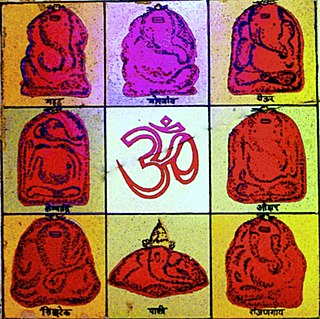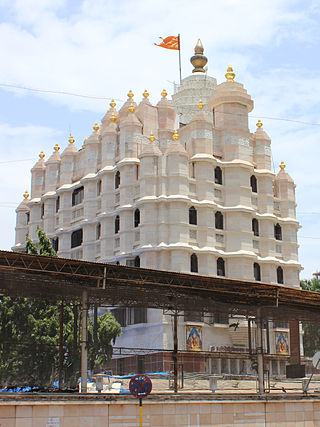
Ashtavinayaka is a Sanskrit term which means "eight Ganeshas". The Ashtavinayaka Yatra refers to a pilgrimage to the eight Hindu temples in the state of Maharashtra, India, centered around the city of Pune. The eight temples house eight distinct idols of Ganesha, the Hindu deity of unity, prosperity, learning, and removing obstacles. Each of these temples has its own individual legend and history, as distinct from each other as the murtis in each temple. The form of each murti of Ganesha and his trunk are distinct from one another. There are other temples of eight Ganesha in various other parts of Maharashtra; however, the ones around Pune are more well known and visited. To complete the Ashtavinayaka Yatra, one must revisit the first temple after visiting all the eight temples.

New Panvel is a residential, commercial and educational node of Navi Mumbai, Raigad District, Maharashtra and comes under the Konkan division. New Panvel was developed on marshy land and was previously a Mango cultivated area. New Panvel is divided into two parts: New Panvel (E), on the eastern side of Panvel railway station and Khanda Colony or New Panvel (W) on the western side of it. Both parts of New Panvel are connected by a flyover bridge also known as Khanda Colony Flyover. New Panvel (W) is also popularly called Khanda Colony by the local villagers, as the city is adjacent to two small villages Dhakta Khanda and Motha Khanda.

Ganesh Chaturthi, also known as Vinayak Chaturthi or Ganeshotsav, is a Hindu festival that tributes Hindu deity Ganesha. The festival is marked with the installation of Ganesha's clay murtis privately in homes and publicly on elaborate pandals. Observances include chanting of Vedic hymns and Hindu texts, such as prayers and vrata (fasting). Offerings and prasada from the daily prayers, that are distributed from the pandal to the community, include sweets such as modak as it is believed to be a favourite of Lord Ganesha. The festival ends on the tenth day after start, when the Murti is carried in a public procession with music and group chanting, then immersed in a nearby body of water such as a river or sea, called visarjana on the day of Ananta Chaturdashi. In Mumbai alone, around 150,000 Murtis are immersed annually. Thereafter the clay Murti dissolves and Ganesha is believed to return to his celestial abode.
Panvel is a city and taluka in Raigad district of Maharashtra, India. It is highly populated due to its closeness to Mumbai. Panvel is also governed for development purpose by the body of Mumbai Metropolitan Region. Panvel Municipal Corporation is the first Municipal Corporation in Raigad and the 27th Municipal corporation of Maharashtra State.

BallaleshwarPali is one of the eight temples of the Hindu God Ganesha. Among Ganesha temples, Ballaleshwar is the only one dedicated to Ganesha that is known by his devotee's name. It is located in the village of Pali which is 28 km from Roha in the Raigad district of Maharashtra, India. It is situated between fort Sarasgad and the river Amba.

The Shri Siddhivinayak Ganapati Mandir is a Hindu temple dedicated to Ganesha. It is located in Prabhadevi neighbourhood of Mumbai, Maharashtra, India. It was originally built by Laxman Vithu and Deubai Patil on 19 November 1801. It is one of the most popular Hindu temples in Mumbai.
Khopoli is an industrial city in the Khalapur taluka of Raigad district, in the Indian state of Maharashtra, at the base of the Sahyadri mountains. Patalganga River, which is the tailrace channel of the Tata Hydroelectric Power Station, flows through Khopoli.

Shri Swaminarayan Mandir, Mumbai is a Hindu temple (Mandir) and a part of the Swaminarayan Sampraday. This Swaminarayan Temple is located in the Bhuleshwar area of Mumbai and is the oldest Swaminarayan Mandir in Mumbai, being over a hundred years old.
The Dashabhuja Temple is a Hindu temple in Pune, in the Maharashtra state of India. This temple was once owned by Sardar Haripant Phadke, a Sardar of Peshwa and was later donated to the Peshwas as dowry. Dashabhuja Ganapati temple is visited by thousands of devotees every day and the number increases during Ganesh Chaturthi. The idol of Ganpati or Ganesh seen here has his elephant trunk resting on his right-hand side, which is supposed to be rarer and more sacred than other forms of the Ganesh idol.

The Siddhivinayaka Mahaganapati Temple is a Hindu temple located in Titwala, a small town in the Kalyan taluka of Thane district – near Mumbai, Maharashtra, India. The temple is dedicated to the Hindu, elephant-headed god of wisdom Ganesha. Titwala is believed to be the putative site of the hermitage of sage Kanva, foster parent of Shakuntala who was born here. The place is steeped in ancient legend and the temple is frequented by a very large number of devotees on account of the belief that separated married couples could be united and marriages of desired people could be fixed easily if the Ganesha image installed in the temple is worshipped with devotion.This temple is frequented mostly on Tuesdays.

Ganesh Jayanti (literally "Ganesha's birthday", also known as Magha shukla chaturthi, Tilkund chaturthi, and Varad chaturthi, is a Hindu festival. This occasion celebrates the birth day of Ganesha, the lord of wisdom. It is a popular festival particularly in the Indian state of Maharashtra and it is also celebrated in Goa held during the shukla paksha chaturthi day in the month of Magha as per the Hindu calendar, which corresponds to the Gregorian calendar month of January/February. In 2022, Ganesh Jayanti falls on 4 February.

Shri Mayureshwar Mandir or Shri Moreshwar Temple is a Hindu temple (mandir) dedicated to Ganesha, god of wisdom. It is located in Moragaon in Pune District, about 65 km away from Pune city in the Indian state of Maharashtra. The temple is the starting and ending point of a pilgrimage of eight revered Ganesha temples called Ashtavinayaka.
Ramji Mahadev Biwalkar was a Maratha General during the Peshwa Period. He is renowned as the builder of the Varadvinayak temple in Mahad.
Urkeri is a small village located in the district of Uttar Kannada in the state of Karnataka in India. It has a population of about 963 persons living in around 214 households. Urkeri is a temple Village. The main deity is Lord Ganesh. Lord Ganesha is revered as the village God in these villages, in the north Kanara district. The chariot ceremony of Ganapati is celebrated on Maghi Pournima. The temple is the main attraction at Urkeri, receiving many devotees per year. Urkeri Shree Swayambhoo Devasthana is an ancient temple.

The Chintamani Temple of Theur is a Hindu temple dedicated to Supreme God Ganesha according to Ganapatya Sect located 25 km (16 mi) from Pune, the temple is "one of the larger and more famous" of the Ashtavinayaka, the eight revered shrines of Ganesha in the Indian state of Maharashtra.

The Siddhivinayak Temple of Siddhatek is a Hindu temple dedicated to Ganesha, the elephant-headed god of wisdom. The temple is one of the Ashtavinayaka, the eight revered shrines of Ganesha in the Indian state of Maharashtra and the only Ashtavinayaka shrine in Ahmednagar district.

The Vigneshwara Temple or Vighnahar Ganapati Temple of Ozar is a Hindu temple dedicated to Ganesha, the elephant-headed god of wisdom. The temple is one of the Ashtavinayaka, the eight revered shrines of Ganesha in Maharashtra, India. The Ganesha form worshipped here is called Vigneshwara or Vignahar and is associated with the legend of Ganesha defeating Vignasura, the demon of obstacles.
Adasa is a village in the Kalmeshwar taluka of Nagpur district in Maharashtra. It is located at a distance of 43 km from Nagpur. Adasa is famous for its magnificent temples. The most popular among these is the Adasa Ganesh Temple, one of the eight ashtavinayaks in Maharashtra's Vidarbha region, dedicated to Lord Ganesha. The village of Adasa is also home to the Lord Mahadev Temple.















